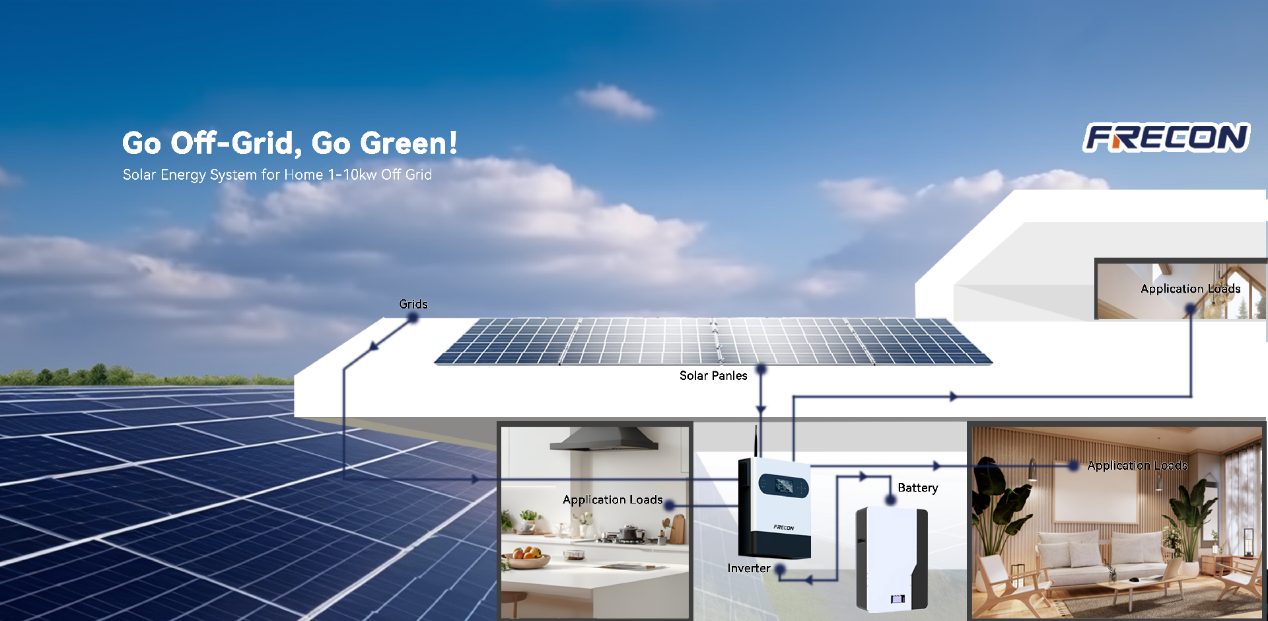It's one of the most common questions new solar homeowners ask: "Should I turn off my solar power inverter for home at night to save electricity?"
The simple, direct answer is: No.
For the vast majority of modern residential systems, your solar panel inverter is designed to be left on 24/7. It's a "set it and forget it" piece of equipment. While it might seem counterintuitive to leave an electrical device running when it's not producing power, turning it off every night can actually interrupt its critical functions, lead to premature wear, and cause more problems than it solves.
Before you flip that switch, let's look at what your inverter is really doing after the sun goes down.

So, What Does a Solar Inverter Actually Do All Night?
To understand why you should leave it on, you first need to understand what "on" really means for an inverter.
Your solar panel inverter is a smart device. Its main job, converting DC power from your panels to AC power for your home, is entirely dependent on sunlight. As the sun sets, the DC voltage from the panels drops. Once it falls below a specific "wake-up voltage" threshold, the inverter automatically stops the power conversion process.
It doesn't "turn off" in the way you'd unplug an appliance. Instead, it enters a very low-power standby mode, essentially going to sleep for the night.
But "standby" doesn't mean "inactive." It's still performing several critical functions in the background, all of which are essential for safety, performance, and reliability:
Grid Monitoring
The inverter continuously monitors the utility grid, checking its voltage and frequency. It needs to ensure the grid is stable and within the correct parameters. This is a crucial safety requirement, as it prevents the inverter from sending power into a downed or unstable grid (a condition called "islanding"), which could endanger utility workers.
Data Logging & Self-Diagnostics
Once the day's power production is over, the inverter finalizes its data logs. It records how much energy you produced, tracks performance, and stores this information.
It also runs internal self-diagnostics, checking its own components (like fans, capacitors, and sensors) to detect and log any potential faults. This ensures that if there's a problem, it's often identified before it causes a major failure.
Awaiting Wake-Up
The inverter is never truly "off" because it's always s waiting for the sun. Its sensors are constantly checking for any sign of DC voltage from the panels.
The instant the first morning light hits the panels and produces enough voltage to cross that "wake-up" threshold, the inverter will automatically run its safety checks and begin the power conversion process. If it were fully 'off,' this automatic start-up wouldn't be possible.
Will a Power Inverter Drain My Battery? What is "Standby Power Loss"?
This is a valid concern for any homeowner, especially those with hybrid or off-grid systems that include battery storage.
The short answer is no. A modern power inverter for home is designed to be incredibly efficient, even in standby mode.
This tiny amount of power consumption is known in the industry as "tare loss," "no-load power consumption," or "standby power consumption." It's the minimum energy required to keep the inverter's "brain"—its monitoring circuits, sensors, and memory—alive.
So, how much power are we talking about?
For a modern residential inverter, this tare loss is typically range from 2% to 5% of its rated power output. In real-world terms, this often translates to just a few watts. This is a negligible amount of energy, far less than what many other household appliances (like your microwave clock or TV on standby) consume.
If you have a battery system, the inverter's Battery Management System (BMS) is designed to handle this, and the standby draw is already factored into the system's overall efficiency. The convenience, safety, and reliability gained from leaving the inverter on far outweigh the minuscule energy cost of its standby mode.
Why Turning Your Inverter Off Every Night is a Bad Idea
Manually shutting down your solar power inverter for home every night might seem like a harmless way to save a tiny bit of power, but in reality, you risk causing significant technical and financial problems.
Here are the primary technical risks of a daily shutdown:
1. Increased Component Stress
Electronic components are most vulnerable during power-up and power-down. Each time you turn the inverter on, it experiences a small inrush of current as its internal capacitors charge.
This on-off cycle causes thermal stress—components heat up when on and cool down when off. Doing this every single day accelerates wear and tear, significantly increasing the chances of an early failure in sensitive components like relays and capacitors, much like how a lightbulb is most likely to burn out the moment you flip the switch.
Forgetting to Turn It Back On
This is the most common and most costly human error. You turn the inverter off at night, and then one morning, you forget to turn it back on. You go to work, the sun is shining, and your panels are ready to produce, but your entire system is sitting idle.
You could lose a full day's worth of solar production and not even realize it until you check your monitoring app or get your next utility bill. This one simple mistake can easily cost you more in lost savings than years' worth of standby power consumption.
Interrupted Diagnostics and Firmware Updates
As mentioned, your inverter runs self-checks and logs data overnight. It also uses this "down" time to receive and install critical firmware updates from the manufacturer to improve efficiency or patch security vulnerabilities.
If your inverter is powered off, it misses this critical maintenance window. It can't run its full diagnostic routines or receive updates, leaving your system running on outdated software and potentially masking fault codes that would have warned you of an impending issue.
Potential Warranty Complications
While it's rare, if your inverter fails prematurely, the manufacturer will almost certainly check its internal data logs.
If these logs show that the unit has been manually power-cycled hundreds or thousands of times, the manufacturer could argue that this constitutes improper use and is outside the bounds of normal operation.
This could give them grounds to dispute or even void your warranty claim, leaving you responsible for the high cost of a replacement unit.
When You Should Turn Off Your Inverter (And How to Do It)
While your solar power inverter for home should be left on 24/7 for normal operation, there are a few specific, non-routine situations where a complete shutdown is necessary.
When to Shut Down the Inverter
l During Scheduled Maintenance: If an electrician or solar technician is performing work on your system or home electrical panel.
l In Emergency Situations: If there is a flood or fire near your equipment, or if instructed to do so by emergency services.
l When Instructed by Your Installer: Your utility or solar installer may ask you to restart the system to clear a fault.
However, you must follow a specific procedure.
How to Safely Shut Down Your Inverter
Always follow the shutdown procedure, which is almost universally AC first, then DC.
l Step 1: Turn Off the AC Supply. Locate your "AC Isolator" switch. This is often a switch in your main electrical panel (switchboard) labeled "Main Switch (Inverter Supply)" or "Solar Supply." Sometimes, it may also be a separate AC isolator switch mounted on the wall next to your inverter. Turn this to the "OFF" position.
l Step 2: Turn Off the DC Supply. Go to the inverter itself. Locate the "PV DC Isolator" or "DC Switch." This is almost always a large rotary switch located on the bottom or side of the inverter unit. Turn switch to the "OFF" position (this often requires a firm 90-degree turn).
l Step 3: Confirm Shutdown. Wait a few moments. The inverter's screen and any status lights should go completely dark, indicating it has fully de-energized.
How to Restart Your Inverter
To turn your system back on, you simply reverse the process: DC first, then AC.
l Step 1: Turn On the DC Supply. Turn the "PV DC Isolator" switch on the inverter back to the "ON" position.
l Step 2: Turn On the AC Supply. Turn the "AC Isolator" or "Main Switch (Inverter Supply)" in your switchboard back to the "ON" position.
l Step 3: Wait for Boot-Up. The inverter is not instant. Its screen will light up, and it will begin a start-up sequence, which typically takes 60 seconds to a few minutes. It is running self-checks and synchronizing with the grid's voltage and frequency before it begins to convert power.
Visit FRECON for More Reliable Inverter Solution
A reliable solar investment accounts largely on a reliable inverter. That’s why at FRECON, we are dedicated to providing advanced power solutions for every application.
For residential and remote home use, our Off-Grid Solar Inverter series is designed for high efficiency and durability. These pure sine wave inverters ensure an uninterrupted energy supply by supporting battery storage, making them ideal for homes without stable grid access.
Whether you are a solar installer sourcing dependable hardware for your clients or a homeowner planning a robust off-grid system, FRECON has the technology to power your project.
Visit our website to learn more about our complete range of solar and off-grid inverter solutions.





